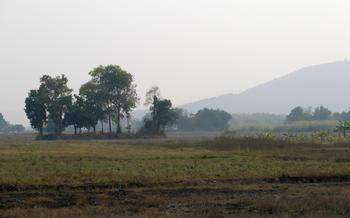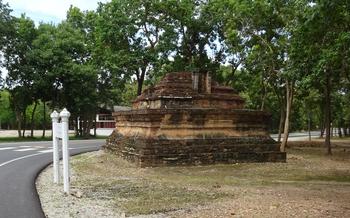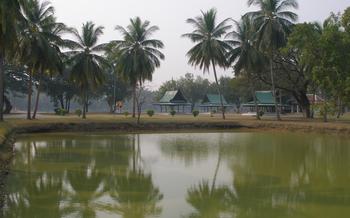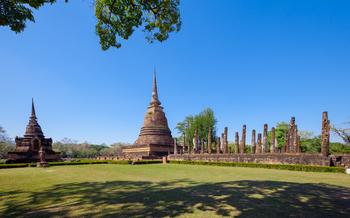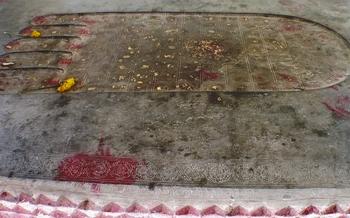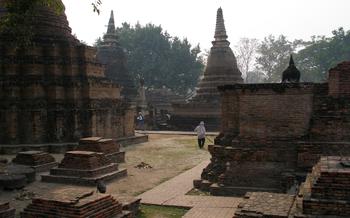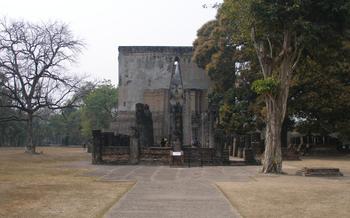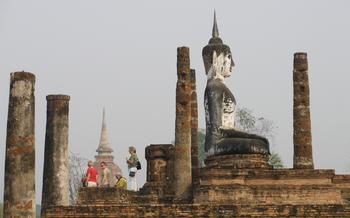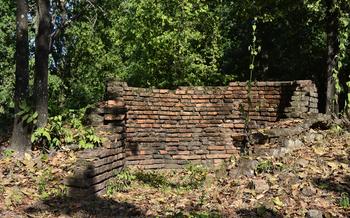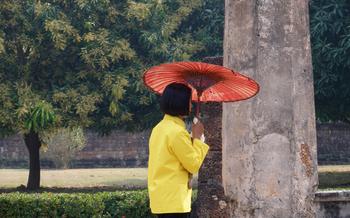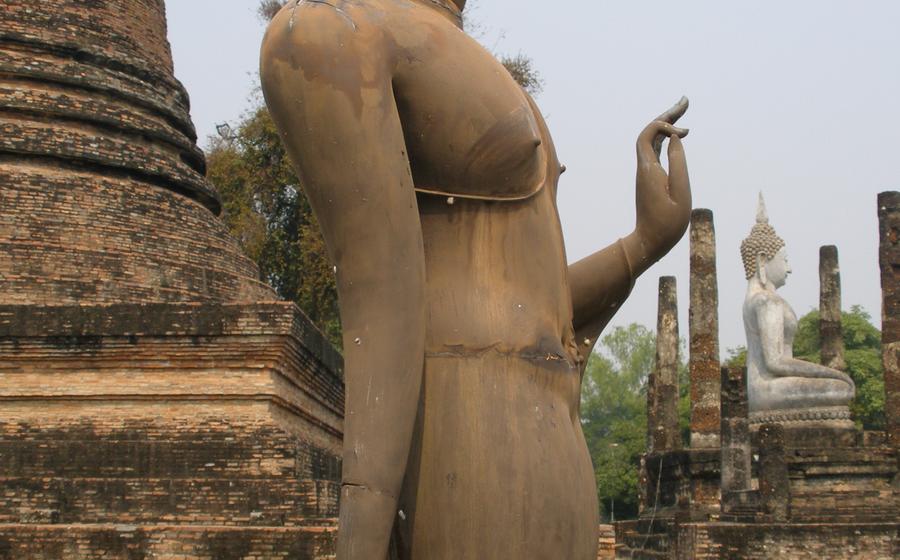
The Celadon Kiln Site Study and Conservation Centre
- The Celadon Kiln Site Study and Conservation Centre
- Location
- What to See
- The Working Kilns
- The Museum
- The Demonstration Area
- Souvenirs
- Food and Drink
- Toilets
- Other Things to Do Nearby
- What to Wear
- Photography
- Accessibility
- Insider Tip
The Celadon Kiln Site Study and Conservation Centre
The Celadon Kiln Site Study and Conservation Centre provides a glimpse into the rich history of celadon production in Thailand. The site is home to the ruins of several kilns that were used to produce celadon ceramics during the Sukhothai period (13th to 15th centuries). These kilns are among the best-preserved examples of their kind in Southeast Asia and offer a unique insight into the craftsmanship and techniques of the ancient Thai potters.
History of the Site
The Celadon Kiln Site Study and Conservation Centre is located on the grounds of the Sukhothai Historical Park, a UNESCO World Heritage Site. The site was first excavated in the 1960s by a team of Thai and Japanese archaeologists. The excavations revealed the remains of several kilns, as well as a large number of celadon shards and other artifacts.
Types of Celadon Produced
The kilns at the Celadon Kiln Site Study and Conservation Centre were used to produce a variety of celadon ceramics, including bowls, plates, vases, and jars. The celadon produced at the site was typically a light green color, with a glossy finish. The ceramics were often decorated with intricate designs, such as flowers, birds, and animals.
Importance of the Site
The Celadon Kiln Site Study and Conservation Centre is an important archaeological site that provides valuable insights into the history of celadon production in Thailand. The site is also a popular tourist destination, as it offers visitors a chance to learn about the ancient Thai culture and see the ruins of the kilns that were used to produce celadon ceramics.
Location
The Celadon Kiln Site Study and Conservation Centre is located in the Mueang Kao district of Sukhothai province, approximately 12 kilometers from the city of Sukhothai. The site is situated in a rural area surrounded by rice fields and small villages, offering a glimpse into the traditional lifestyle of the local people.
To get to the site, you can take a tuk-tuk or a songthaew (shared taxi) from Sukhothai city. The journey takes about 30 minutes and costs around 100-150 baht. Alternatively, you can rent a bicycle and explore the countryside at your own pace. The ride takes about 1-2 hours, depending on your fitness level.
What to See
The Celadon Kiln Site Study and Conservation Centre is home to a number of interesting features, including the kilns themselves, a museum, and a demonstration area.
The kilns are the most impressive feature of the site. There are a total of 12 kilns, all of which are in good condition. Visitors can walk through the kilns and see how they were used to fire celadon pottery.
The museum is located in a traditional Thai-style building. It houses a collection of artefacts from the site, including celadon pottery, tools, and kiln furniture. The museum also has displays on the history of celadon production in Thailand.
The demonstration area is located next to the museum. Here, visitors can watch potters at work and learn about traditional celadon techniques. Visitors can also try their hand at making their own celadon pottery.
The Working Kilns
The Celadon Kiln Site Study and Conservation Centre is home to several working kilns, where visitors can observe the traditional celadon firing process. The kilns are operated by skilled artisans who use the same techniques that have been passed down through generations.
The firing process is a complex and delicate one. First, the kilns are packed with carefully arranged pieces of celadon pottery. Once the kilns are full, they are sealed and the firing process begins.
The firing process takes several days and nights. During this time, the temperature inside the kilns is gradually increased until it reaches a peak of over 1000 degrees Celsius. The high temperature causes the clay to harden and the glaze to melt, creating the beautiful celadon colour.
Once the firing process is complete, the kilns are allowed to cool slowly. This process can take several days, as the kilns must cool down gradually to prevent the pottery from cracking.
The different types of celadon produced at the kilns vary depending on the clay and glaze used. The most common type of celadon is green, but it can also be produced in a variety of other colours, including blue, brown, and yellow.
The working kilns at the Celadon Kiln Site Study and Conservation Centre are a fascinating sight to behold. Visitors can learn about the traditional celadon firing process and see how these beautiful pieces of pottery are created.
The Museum
The museum at the Celadon Kiln Site Study and Conservation Centre is a must-see for anyone interested in the history of celadon production in Thailand. The museum houses a collection of artefacts from the site, including celadon pottery, tools, and kiln furniture. There are also displays on the history of celadon production in Thailand, as well as interactive exhibits that allow visitors to learn more about the process.
One of the most interesting exhibits in the museum is a replica of a celadon kiln. The kiln is made of clay and is fired using wood. Visitors can watch a demonstration of how the kiln works and learn about the different types of celadon that were produced at the site.
The museum also has a collection of celadon pottery that was produced at the site. The pottery is of various shapes and sizes, and it is decorated with a variety of patterns. Visitors can see how the celadon pottery was made and learn about the different techniques that were used to decorate it.
The Celadon Kiln Site Study and Conservation Centre is a valuable resource for anyone interested in the history of celadon production in Thailand. The museum is well-organized and informative, and it provides a unique opportunity to learn more about this ancient craft.
The Demonstration Area
The demonstration area is a great place to learn about traditional celadon techniques and watch potters at work. You can see how the clay is prepared, how the pots are shaped, and how the glaze is applied. There are also interactive exhibits where you can try your hand at making your own celadon.
If you're interested in learning more about celadon pottery, the demonstration area is a must-visit. You'll be able to see the entire process of celadon production, from start to finish. And if you're feeling creative, you can even try your hand at making your own piece of celadon pottery.
Here are some tips for making the most of your visit to the demonstration area:
- Arrive early. The demonstration area is most crowded in the afternoon, so it's best to arrive early in the morning if you want to avoid the crowds.
- Wear comfortable shoes. You'll be doing a lot of walking in the demonstration area, so it's important to wear comfortable shoes.
- Bring your camera. The demonstration area is a great place to take photos of the potters at work and the beautiful celadon pottery.
- Ask questions. The potters in the demonstration area are very friendly and knowledgeable, so don't be afraid to ask them questions about their work.
Souvenirs
Where to buy souvenirs:
There are several shops at the Celadon Kiln Site Study and Conservation Centre where you can buy souvenirs. You can find everything from small celadon trinkets to large vases and urns. There are also a number of shops in the old city of Sukhothai where you can buy celadon souvenirs.
What to buy:
Some of the most popular celadon souvenirs include:
- Celadon bowls
- Celadon vases
- Celadon urns
- Celadon figurines
- Celadon jewelry
How to bargain for souvenirs:
Haggling is expected at the Celadon Kiln Site Study and Conservation Centre and in the old city of Sukhothai. When bargaining, it is important to be polite and respectful. Start by offering a price that is about half of the asking price. The seller will likely counteroffer. Continue to haggle until you reach a price that you are both happy with.
Food and Drink
There are a few places to buy food and drink at the Celadon Kiln Site Study and Conservation Centre. There is a small cafe that sells snacks and drinks, and there are also a few food stalls that sell Thai food. The prices are reasonable, and the food is generally good.
If you are looking for a more substantial meal, there are a few restaurants located near the centre. These restaurants serve a variety of Thai and international dishes, and the prices are generally higher than at the food stalls.
No matter where you choose to eat, be sure to try some of the local specialties, such as khao soi (a northern Thai noodle curry), or som tam (a spicy papaya salad).
Insider Tip:
If you are looking for a unique dining experience, you can try one of the many floating restaurants in Sukhothai. These restaurants are located on boats that float on the Yom River, and they offer stunning views of the city.
Toilets
Toilets are available at the site, but they are not always clean. It is a good idea to bring your own toilet paper and hand sanitizer. There is a small fee to use the toilets.
Other Things to Do Nearby
In addition to visiting the The Celadon Kiln Site Study and Conservation Centre, there are many other things to see and do in Sukhothai. The city is home to a number of other tarihi sites, including the Sukhothai Historical Park, which is a UNESCO World Heritage Site. The park is home to the ruins of the ancient city of Sukhothai, which was once the capital of the Sukhothai Kingdom. Other notable tarihi sites in Sukhothai include the Wat Mahathat, the Wat Si Chum, and the Wat Phra Ram.
In addition to its tarihi sites, Sukhothai is also a great place to explore the old city. The old city is home to a number of traditional Thai houses, temples, and markets. Visitors can wander through the streets of the old city and soak up the unique atmosphere.
Sukhothai is also a great place to go shopping for souvenirs. The city is home to a number of markets where visitors can find a variety of souvenirs, including celadon pottery, silk scarves, and wood carvings. Visitors should be sure to bargain for the best prices.
What to Wear
When visiting the The Celadon Kiln Site Study and Conservation Centre, it is important to dress appropriately. The site is a religious and cultural one, so it is important to be respectful of the local customs. Shorts, tank tops, and revealing clothing are not appropriate. Instead, opt for loose-fitting, long pants or skirts, and a shirt that covers your shoulders. It is also important to wear comfortable shoes, as you will be doing a lot of walking.
Avoid wearing anything that is too flashy or attention-grabbing. This is not the place to show off your latest fashion trends. Instead, dress in a way that is simple and respectful.
If you are visiting during the hot season, it is important to wear light-colored clothing and to stay hydrated. There is not a lot of shade at the site, so it is important to protect yourself from the sun.
By dressing appropriately, you can show your respect for the local culture and make the most of your visit to the The Celadon Kiln Site Study and Conservation Centre.
Photography
Is photography allowed?
Yes, photography is allowed at the Celadon Kiln Site Study and Conservation Centre. In fact, it is encouraged! The staff are happy for visitors to take photos and share them with others.
Where are the best places to take photos?
The best places to take photos are around the kilns, the museum, and the demonstration area. The kilns are particularly photogenic, especially when they are firing. The museum has some interesting displays on the history of celadon production in Thailand, and the demonstration area is a great place to watch potters at work.
Tips for taking great photos
Here are a few tips for taking great photos at the Celadon Kiln Site Study and Conservation Centre:
- Use a wide-angle lens to capture the full scale of the kilns.
- Get close to the kilns to show the detail of the construction.
- Take photos of the potters at work to capture the traditional techniques used to make celadon.
- Experiment with different angles and perspectives to find the best composition for your photos.
- Use a tripod to stabilize your camera and avoid blurry photos.
Accessibility
The Celadon Kiln Site Study and Conservation Centre is wheelchair accessible, with ramps and elevators providing easy access to all areas of the site. Designated parking spaces for disabled visitors are available near the entrance, and there are accessible restrooms throughout the complex. Visitors with disabilities can also borrow wheelchairs from the visitor center upon request.
To make the most of your visit, consider contacting the center ahead of time to inquire about any special accommodations or assistance you may need. The staff is friendly and helpful and will be more than happy to assist you in any way they can. They can also provide information about accessible tours and workshops that may be available during your visit.
Insider Tip
If you want to avoid the crowds and enjoy a more relaxed visit, try to come during the week, early in the morning or late in the afternoon. You can find the best deals on souvenirs at the souvenir shops located outside the main entrance of the site. Here, you'll find a wide variety of celadon items to choose from, including plates, bowls, vases, and figurines, all at very reasonable prices. Be sure to haggle with the vendors to get the best possible price.
